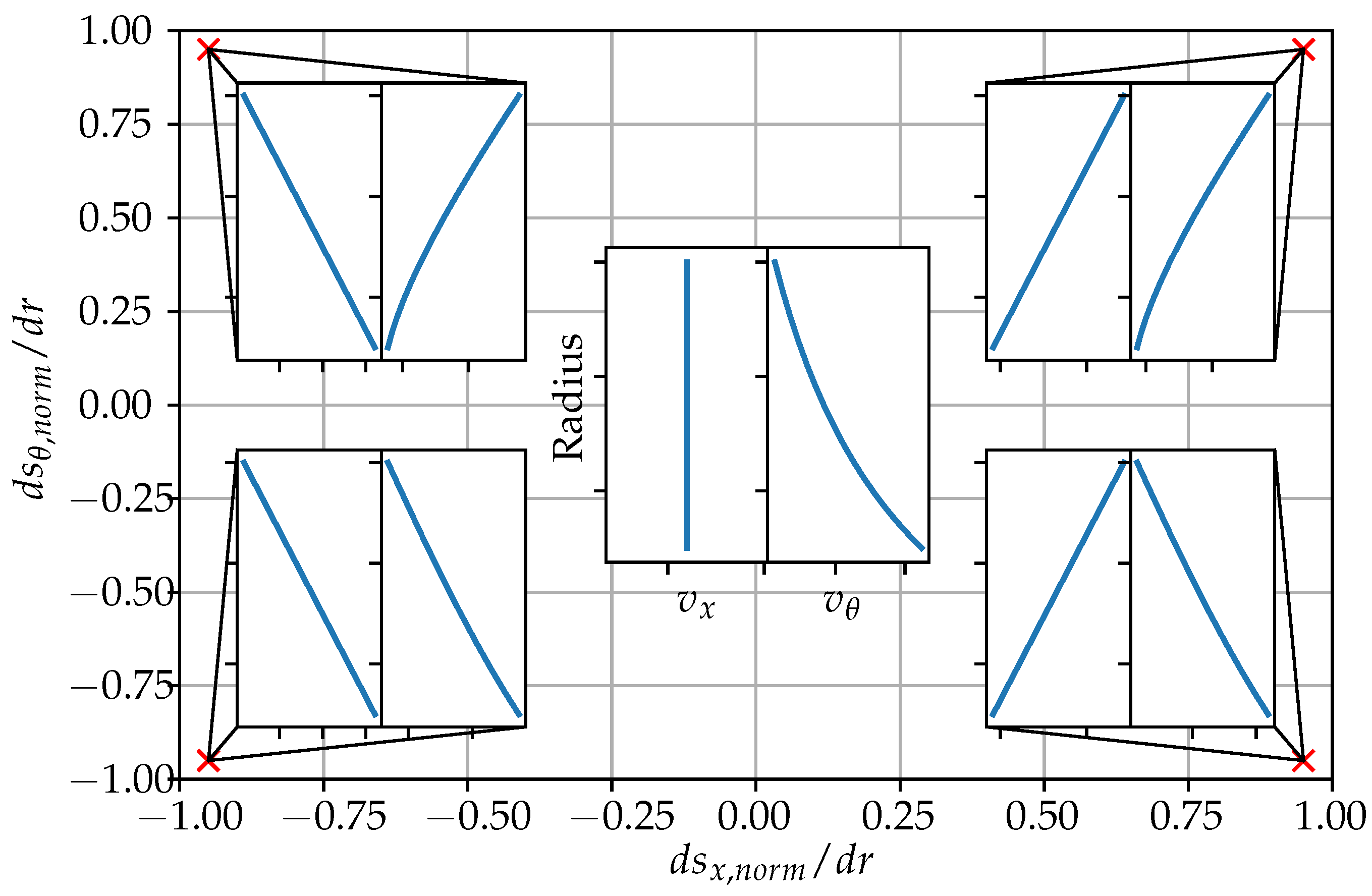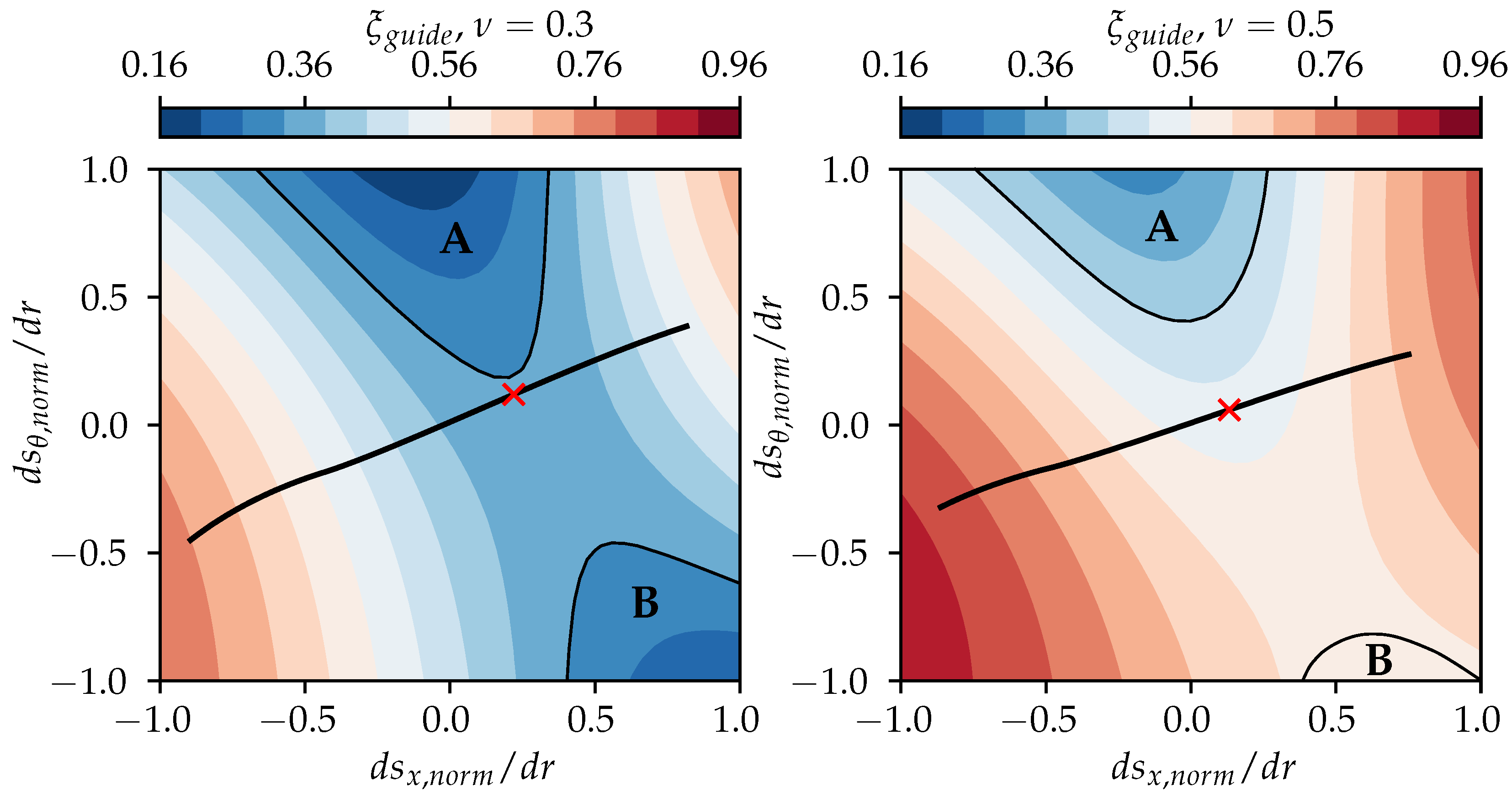Potential of Static Pressure Recovery of Rotor-Only Low-Pressure Axial Fans †
Abstract
:1. Introduction
- What is the maximum effect that can be achieved via optimum static pressure recovery and how can it be evaluated?
- To what extent can the static pressure recovery be influenced by the geometric features of the machine and the vortex design?
2. Static Pressure Recovery of Rotor-Only Low-Pressure Axial Fans
2.1. Assumptions and General Mechanism
- At location 0, immediately downstream of the trailing edge, the flow is axisymmetric, inviscid, and has no radial velocity components and no meridional curvature of the exit streamlines;
- The ambient pressure is imprinted on the shear layer between the fan discharge and the free atmosphere (i.e., at );
- Location 1 is positioned sufficiently far downstream of location 0, such that the circumferential velocity component of the discharge has entirely vanished via momentum exchange (i.e., mixing) with the environment;
- The free atmosphere is sufficiently large, such that walls and other obstructions are not influencing the free exhaust;
- The flow is assumed to be steady and incompressible.
2.2. Evaluation Criterion of the Static Pressure Recovery
2.3. Modeling of Static Pressure Recovery
3. Methodology
3.1. Idealized Reference Design
3.2. Two-Dimensional Design Space
4. Results of the Design Space Exploration
5. Discussion
6. Conclusions
Author Contributions
Funding
Data Availability Statement
Conflicts of Interest
References
- Marcinowski, H. Optimalprobleme bei Axialventilatoren. Ph.D. Thesis, Technische Hochschule Karlsruhe, Karlsruhe, Germany, 1957. [Google Scholar]
- Marcinowski, H. Druck- und Geschwindigkeitsverteilung hinter dem Laufrad eines Axialventilators. Voith Forsch. Und Konstr. 1957, 2, 5:1–5:17. [Google Scholar]
- Bamberger, K.; Carolus, T. Achievable Total-to-Static Efficiencies of Low-Pressure Axial Fans. In Proceedings of the International Conference on Fan Noise, Fan Technology and Numerical Methods, Lyon, France, 15–17 April 2015. [Google Scholar]
- Bamberger, K.; Carolus, T. Performance Prediction of Axial Fans by CFD-Trained Meta-Models. In Proceedings of the ASME Turbo Expo 2014: Turbine Technical Conference and Exposition, Düsseldorf, Germany, 16–20 June 2014. [Google Scholar]
- Čantrak, Ð.S.; Janković, N. Laser Insight Into the Turbulent Swirl Flow Behind the Axial Flow Fan. In Proceedings of the ASME Turbo Expo 2014: Turbine Technical Conference and Exposition, Düsseldorf, Germany, 16–20 June 2014. [Google Scholar]
- Louw, F.G.; von Backström, T.W.; van der Spuy, S.J. Investigation of the Flow Field in the Vicinity of an Axial Flow Fan during Low Flow Rates. In Proceedings of the ASME Turbo Expo 2014: Turbine Technical Conference and Exposition, Düsseldorf, Germany, 16–20 June 2014. [Google Scholar]
- Witte, H.; Bode, C.; Friedrichs, J. Potential of Static Pressure Recovery of Rotor-Only Low Pressure Axial Fans. In Proceedings of the 15th European Turbomachinery Conference, paper n. ETC2023-157, Budapest, Hungary, 24–28 April 2023; Available online: https://www.euroturbo.eu/publications/conference-proceedings-repository/ (accessed on 6 September 2023).





| Parameter | RPM | ||||
|---|---|---|---|---|---|
| Value | 0.215 | 0.300 | 0.250 m | 1350 min | 0.3, 0.5 |
Disclaimer/Publisher’s Note: The statements, opinions and data contained in all publications are solely those of the individual author(s) and contributor(s) and not of MDPI and/or the editor(s). MDPI and/or the editor(s) disclaim responsibility for any injury to people or property resulting from any ideas, methods, instructions or products referred to in the content. |
© 2023 by the authors. Licensee MDPI, Basel, Switzerland. This article is an open access article distributed under the terms and conditions of the Creative Commons Attribution (CC BY-NC-ND) license (https://creativecommons.org/licenses/by-nc-nd/4.0/).
Share and Cite
Witte, H.; Bode, C.; Friedrichs, J. Potential of Static Pressure Recovery of Rotor-Only Low-Pressure Axial Fans. Int. J. Turbomach. Propuls. Power 2023, 8, 33. https://doi.org/10.3390/ijtpp8030033
Witte H, Bode C, Friedrichs J. Potential of Static Pressure Recovery of Rotor-Only Low-Pressure Axial Fans. International Journal of Turbomachinery, Propulsion and Power. 2023; 8(3):33. https://doi.org/10.3390/ijtpp8030033
Chicago/Turabian StyleWitte, Hauke, Christoph Bode, and Jens Friedrichs. 2023. "Potential of Static Pressure Recovery of Rotor-Only Low-Pressure Axial Fans" International Journal of Turbomachinery, Propulsion and Power 8, no. 3: 33. https://doi.org/10.3390/ijtpp8030033
APA StyleWitte, H., Bode, C., & Friedrichs, J. (2023). Potential of Static Pressure Recovery of Rotor-Only Low-Pressure Axial Fans. International Journal of Turbomachinery, Propulsion and Power, 8(3), 33. https://doi.org/10.3390/ijtpp8030033





